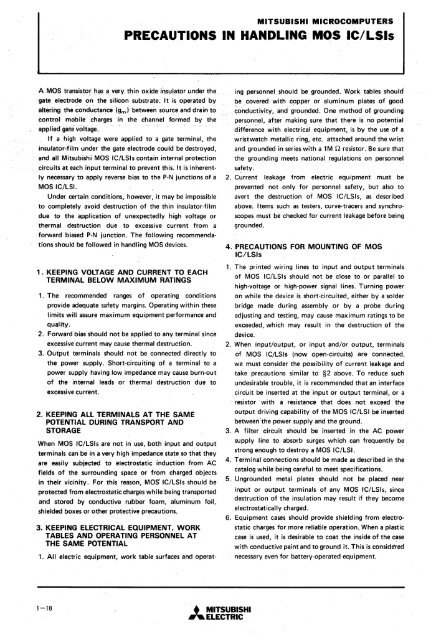mitsubishi - Al Kossow's Bitsavers
mitsubishi - Al Kossow's Bitsavers
mitsubishi - Al Kossow's Bitsavers
You also want an ePaper? Increase the reach of your titles
YUMPU automatically turns print PDFs into web optimized ePapers that Google loves.
MITSUBISHI MICROCOMPUTERSPRECAUTIONS IN HANDLING MOS IC/LSlsA MOS transistor h~s.a very thin oxide insu.lator .under thegate electrode on the silicon substrate. It is operated byaltering the conductance (gm)·· between source and drain tocontrol mobile charges in the channel formed by theappl iedgate voltage.If a high voltage were applied to a gate terminal, theinsulator-film under the gate electrode could be destroyed,and all Mitsubishi MOS IC/lSls contain internal protection.circuits at each input terminal to prevent this. It is inherentlynecessary to apply reverse bias to the P-N junctions of aMOS IC/lSI.Under certain conditions, however, it may be impossibleto completely avoid destruction of the thin insulator·filmdue to the application of unexpectedly high voltage orthermal destruction due to excessive current from aforward biased P-N junction. The following recommendationsshould be followed in handling MOS devices.1. KEEPING VOLTAGE AND CURRENT TO EACHTERMINAL BELOW MAXIMUM RATINGS1. The recommended ranges of operating conditionsprovide adequate safety margins. Operating within theselimits will assure maximum equipment performance andquality.2. Forward bias should not be applied to any terminal sinceexcessive current may cause thermal destruction.3. Output terminals should not be connected directly tothe power supply. Short-circuiting of a terminal to apower supply having low impedance may cause burn-outof the internal leads or thermal destruction due toexcessive current.2. KEEPING <strong>Al</strong>l TERMINALS AT THE SAMEPOTENTIAL DURING TRANSPORT ANDSTORAGEWhen MOS IC/lSls are not in use, both input and outputterminals can be in a very high impedance state so that theyare easily subjected to electrostatic induction from ACfields of the surrounding space or from charged objectsin their vicinity. For this reason, MOS' IC/lSIs should beprotected from electrostatic charges while being transportedand stored by conductive rubber foam, aluminum foil,shielded boxes or other protective precautions.3. KEEPING ELECTRICAL EQUIPMENT, WORKTABLES AND OPERATING PERSONNEL ATTHE SAME POTENTIAL1. <strong>Al</strong>l electric equipment, work table surfaces and operatingpersQnnelshould be grounded. W.ork tables shouldbe covered withcppper or aluminum plates of good~onductivity, and grounded. One method of groundingpersonnel, after making sure that there is no potentialdiffere~ce with elect~ic~1 equipment,· is by the us~ ~f awristwatch metallic ring, etc. attached around the wristand grounded in series with a 1 M n resistor. Be sure thatthe grounding meets national regulations on personnelsa!ety.2. Current leakage from electric equipment must beprevented not only for personnel safety, but also toavert the destruction of MOS IC/lSls, as describedabove. Items such as testers, curve-tracers and synchro·scopes must be checked for current leakage before beinggrounded.4. PRECAUTIONS FOR MOUNTING OF MOSIC/lSls1. The printed wiring lines to input and output terminalsof MOS IC/lSls should not be close to or parallel tohigh~voltageor high-power signal lines. Turning poweron while the device is short-circuited, either by a solderbridge made during assembly or by a probe duringadjusting and testing, may cause maximum ratings to beexceeded, which may result in the destruction of thedevice.2. When inputloutput, or input andlor output, terminalsof MOS IC/lSIs (now open-circuits) are connected,we must consider the possibility of current leakage andtake precautions similar to §2 above. To reduce suchundesirable trouble, it is recommended that an interfacecircuit be inserted at the input or output terminal, or aresistor with a resistance that does not exceed theoutput driving capability of the MOS IC/lSI be insertedbetween 'the power supply and the ground.3. A filter circuit should be inserted in the AC powersupply line to absorb surges which can frequently bestrong enough to destroy a MOS I C/lSI.4. Terminal connections should be made as described in thecatalog while being careful to meet specifications.5. Ungrounded metal plates should not be placed nearinput or output terminals of any MOS IC/lSls, sincedestruction of the insulation may result if they becomeelectrostatically charged.6. Equipment cases should provide shielding from electro·static charges for more reliable operation. When a plasticcase is used, it is desirable to coat the inside of the casewith conductive paint and to ground it. This is conside'rednecessary even for battery-operated equipment.1-18 • MITSUBISHI"ELECTRIC

















